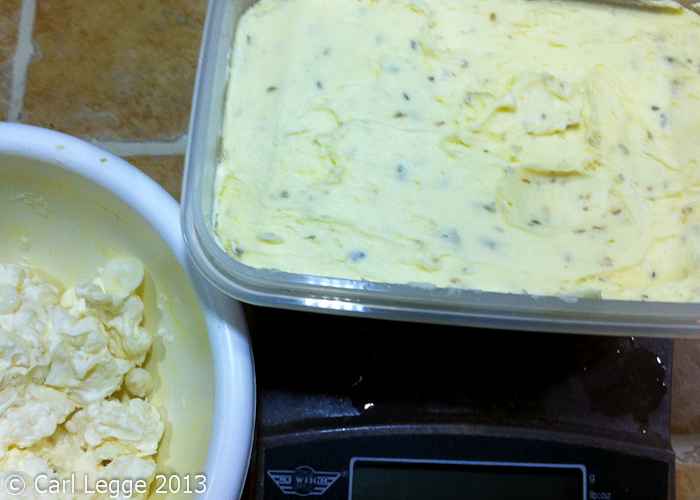
Morocco has a special place in my heart as that’s where I had my honeymoon well over 20 years ago. Since then, I’ve maintained a keen interest in Moroccan & other North African cuisine.
One of the ingredients that is traditional to this part of the world is Smen (also called sman, semneh, or sminn) which is a cultured, salted and flavoured butter which keeps for ages. It’s normally made from sheep or goat’s milk. You’ll see it used to spread on flatbreads, to flavour tagines and cous cous. Jamie Oliver uses it for his recipe for mechoui lamb that I wanted to cook, so I decided to see if I could make my own smen.
Most of the recipes for it that I have found on the web and in my book involve clarifying butter. This is then kneaded with salt and an infusion of herbs (oregano or fenugreek). The butter is then packed and sealed and stored to mature. In others unclarified butter has the salt & herbs added and it’s then clarified.
The web tells of Berber herds people who will bury a sealed container of smen on the day of a daughter’s birth, aging it until it is unearthed and used to season the food served on that daughter’s wedding. I’ve no idea if this is true.
I’ve been playing with milk kefir grains for a while now. I wondered if I could use them to make smen from scratch with cream without the need to clarify already made butter. Read on for my story about how this might have happened in North Africa and for my method…
Carl and the Hundred and One nights
I am in North Africa on a cold morning just as dawn breaks. I’ve been out for a few days to search for good grazing for my goats. I milk the goats and decant each jug of the the still steaming milk into my traditional goat hide bag. Through the passage of the day, due to the heat, the movement of the bag and the microflora inside the bag, the milk naturally begins to ferment and thicken.
When I get back home I hang up the bag while I light a fire and start to heat water for tea. When I return to the bag, the milk smells slighty acidic and is much thicker than before. I take the precious liquid from the bag with an old wooden ladle and carefully put it in a small churn. I quickly & rhythmically work the churn to make butter and whey from the milk. To the butter I add some valuable salt and flavour it with some herbs I picked while out grazing. To keep it from the heat I seal it in a container and bury it in the ground so it will last for years. I’ll make some flat bread with flour and the leftover whey and cook it over the fire’s ruby embers.
I count myself very lucky to be able to save so much of the bounty from my goats. My friends and relatives will be very impressed as I let the smen age and mature. My stock of smen is a potent symbol of my riches.
*****
So the kefir-like stuff in the goat’s hide bag cultures the milk and thickens it. The now cultured/fermented liquid is then used to make the butter/smen. In this method, the water (whey) is separated when you make the butter. With the clarified method, the water is boiled away. So you get some cultures with the kefir method and some cooking with the clarified method.
Anyway, enough of this. Here’s how I made it…
How to make smen with milk kefir
So first get yourself some milk kefir grains. If you know someone who ‘does’ kefir, then they’ll probably have surplus grains to give you: it multiplies fast. You can also buy milk kefir grains online.
Above you can see I’ve put a small handful in a clean, 1 litre glass container. And below with about 600ml of double cream added.
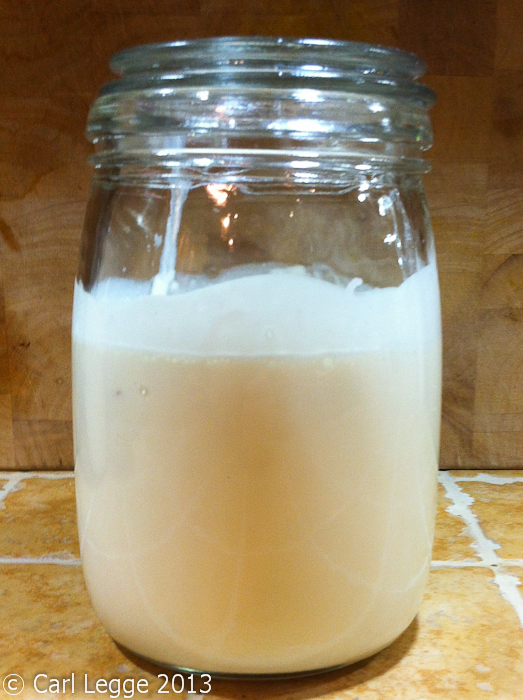 Leave this at room temperature for 24-48 hours and the cream will noticeably thicken.
Leave this at room temperature for 24-48 hours and the cream will noticeably thicken.
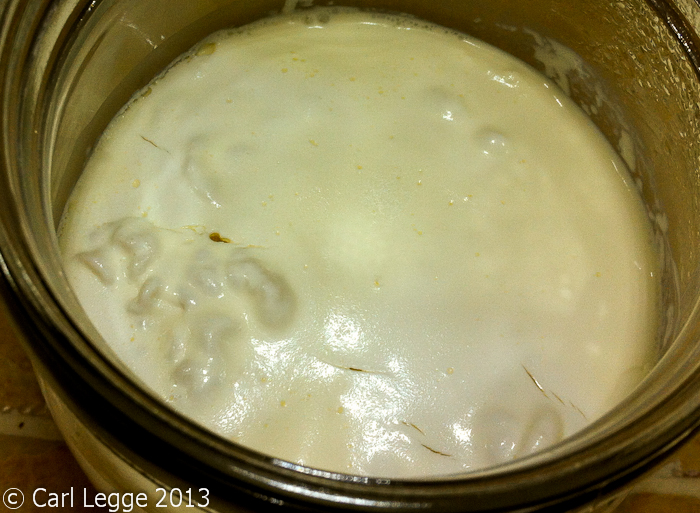 Here you can see the kefir grains lurking in the top layer of cream. This will now be slightly acidic. If you weren’t making smen, you could use it now as a sort of creme fraiche or mascarpone. It’s lovely.
Here you can see the kefir grains lurking in the top layer of cream. This will now be slightly acidic. If you weren’t making smen, you could use it now as a sort of creme fraiche or mascarpone. It’s lovely.
The next stage is messy – there’s no easy way round this I’m afraid. Separate the kefir grains from the cream- use your hands and have some water handy to clean yourself and the kitchen with.
Then put the cream into the bowl of your trusty Kenwood Chef with the K-beater or balloon whisk. You can use any other mixer with a paddle/whisk or a handheld cake mix beater. Failing this, put the butterfat into a jar with a lid. Beat, agitate or shake your fat (!) until it forms butter and whey. If you’re doing this with a machine, be careful as it will suddenly split and you could end up with whey all over the place. You’ll see and hear the mix changing, so be cautious. Save the whey for making bread, muffins or drinks.
Here you can see the butter has formed, some residual whey left at the bottom (there was loads more).
Then take your new butter and in small handfuls squeeze it and wash it under some cold water over a colander or sieve to catch any bits of butter. By doing this, you will squeeze out the remaining whey. You want to get rid of as much as possible as the water provides a habitat for bacteria and your butter may spoil more easily. Keep washing & squeezing until the butter runs clear. I do small pieces at a time as I find it easier to squeeze efficiently. You can also beat/squeeze the butter in a bowl with the back of a wooden spoon. You should be left with something like this.
Weigh your butter and add about 1% by weight of salt. And add about one teaspoon of oregano to each 200g of butter (or to taste). Knead the salt and herbs into the butter. You may produce some more whey, just dab this off with a piece of kitchen towel.
Put your finished smen in a clean container. Then you can bury it in the soil, your local peat bog or pop it in the fridge.
I think the taste is of a mildly cheesy butter with a lovely background seasoning. The taste would obviously be stronger if I’d used goats’ or ewes’ milk. I’ll see how the taste of the smen changes with time – if there’s enough there. You see why you have to be rich to be able to store it for a long time 😉
I will give the clarified butter methods a go and also try this with some raw goat’s milk when I can get hold of some. I will report back on this blog.
Smen & kefir research and Bog Butter
My story above is not completely far-fetched.This research from Iran is about use of a goat hide bag to produce kefir grains and to thicken milk Kefir Production in Iran.
This web-link gives some more cultural and historic information about Smen, along with a recipe for the clarified butter method Butter & Smen in the Arab World
Burying butter is not limited to North Africa. Here are two links to finds in Ireland: BogButter1 and BogButter2 .
If you have a go at any of the methods or know more about this than me, please leave a comment. Thanks 🙂
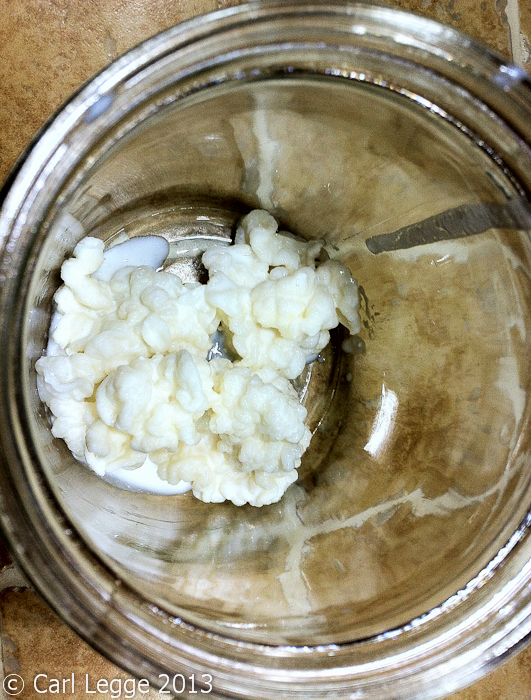
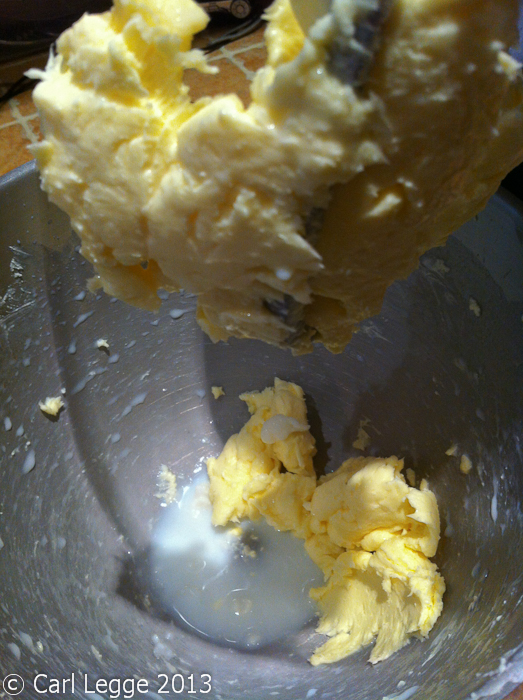
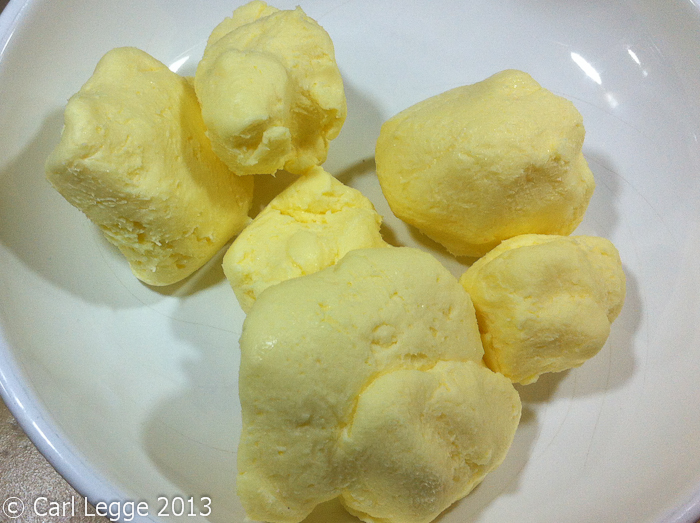
Comments
17 responses to “How to make Smen, Moroccan fermented butter”
Kefir did not originate in milk but were migrated into milk from their home habitat as excruessences on the sides of betula trees. Water kefir can be slowly converted into milk kefir in about a month by adding a little more milk to the solution at each change. Go slowly at first. Water kefir can be substantially dehydrated and scrunched into a tight ball and wrapped tight in plastic and stored in you fridge for a good year and still be revitalised by immersion in a sugar solution. A lot of cows these days are semi permanently on antibiotics and the metabolites are expressed in the milk you buy which has a tendency to kill off milk kefir. You should therefore use organic milk if you can it even better milk your own cow. But to survive long in kefir world you must come to grips with keeping a supply of water kefir grains which you can convert into milk kafir when required. You should look up DomsKefir on chariot. Dom is a great guy who is one of the repositories of all wisdom kefir. I am a skite who knows even more about some aspects of kefir than even the most luminous Dom. Despite the boasting on my part I seriously commend to you The Great Dom – King of All Things Kefir – what you can learn from Dom you can’t learn from anyone else….he has been the global guru of Kefir for 30 years. ..it doesn’t matter whether you are a researcher working out of day Boston or St Petersburg of Tokyo. ..Dom is the guru. ..and if you contact him tell him Pete says hi to he and Helen
Thanks for all this information – brilliant stuff 🙂
I’m a devotee of Dom, lots of useful info and not just about kefir on his site. We’re on opposite sides of the world, but if we meet I will pass on your regards.
Cheers
Carl
can you make smen with goat milk? Will it thicken into a cream? I see some folks above talking about using goat butter, but is whole goat milk creamy enough to do this with?
Louise, I’ve certainly had success making cheese & butter with goat’s milk & kefir grains. Much will depend on the precise fat content of the milk that you have available. It’s certainly worth having a try with a small aount of what you have to see I’d think.
Carl
where can I get the kefir grains .Thank you!
I think it looks Smendid!
*picks self up from floor* Also I might try it. Am just getting the hang of my kerir-babies.
Oh dear Mitch :0
Let me know how you get on 😉
Ha ha! I see, it is one of those hands-in experiences :))) I must give this a go, thanks for this post Carl x
It can be 😉
I did my last lot without the furtling and allowed the grains to either be mashed or appear out of the butter. Seemed to work ok and a lot less effort. I thought they might help continuing fermentation.
I got the goat butter at Whole Foods ($5.69 for 8oz); they had goat milk for $4.69 a quart. I bought 1 lb of goat butter and a few pounds of organic butter (I am making ghee.) I thought I would take 8oz of the organic buter and mix it with the goat butter for the smen. I wanted to extend it. I noticed in research that they did mix the milk of the water buffalo and the sheep and/or goat for some of their recipes. So I thought it couldn’t hurt. I would like to make my own goat butter from the milk. What would the yield be from one quart (i.e., 1 litre)?
I did find some goat’s milk at Whole Foods, but also found some goat butter there. I got organic butter for $4 a pound. I want to mix it with the goat butter to extend it without the pinch of $5.69 for 8 oz. I made Mourad Lahlou’s Harissa recipe using San Marzano Tomatoes. I look forward to trying yours too! As a matter of fact, I downloaded to keep with my other favorite recipes. This is fun!
Glad you are having fun Tomessa 😀
I am glad I found this site! I made smen with regular butter earlier this week and now I am making it with unpasteurized goat butter. I decided to do this after I found 8 oz of the stuff on line for bout $8 with an $12 shipping charge! All of this for my new passion — Moroccan cooking! I am also a medievalist so thanks for the info on the Bogbutter. Fascinating!!
Thanks! I’m glad to be of help. Perhaps you can get hold of some goats milk to try making form scratch. Moroccan cooking a lovely passion to have, you might like my harissa recipe in that case http://www.carllegge.com/2012/11/schug-and-harissa-recipes/
Thanks for taking the time to comment 🙂
I do wish you’d stop posting things I am unable to try due to my current circumstances 😉 I thought of bog butter as soon as you started talking about burying butter…. Did you see Jeremy Cherfas’ podcast on the topic? It sounds as though it has a flavour only its mother could love…. http://www.eatthispodcast.com/?p=16
Hi Emma – thanks for the #BlogLove. I will look/listen to the podcast with interest 🙂
And for anyone else, read more about Emma’s April Blog Love Challenge here http://emmacooper.org/blog/april-blog-love-challenge
[…] served it with a tasty lamb tangia slow cooked for 7 hours and which had some of the Smen I blogged about […]